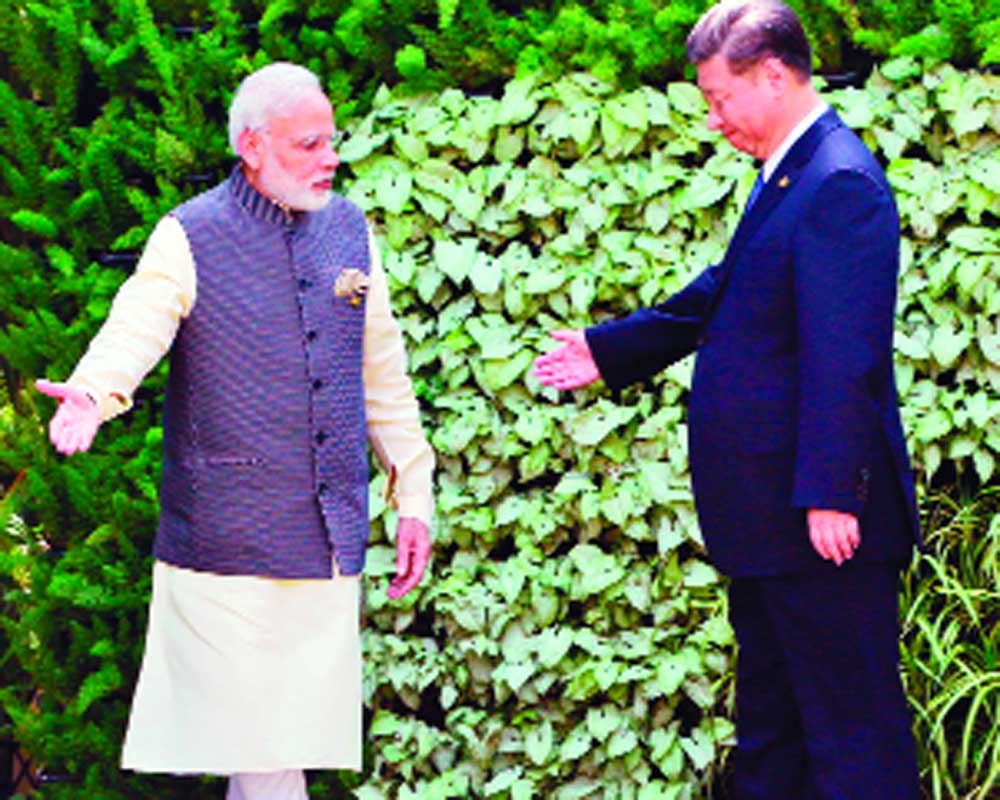Ultimately economic concerns of both nations will underpin the matrix of a one-on-one working relationship
By now an informal meeting between Prime Minister Narendra Modi and Chinese President Xi Jinping has been a protective shaft, cushioning the simmering tension between both nations. The two leaders embody the Wuhan spirit in a total recall of their first friendly face-to-face that staved off mutual territorial confrontation in Doklam. And though friction is inevitable in an asymmetrical relationship with the Chinese speaking in a forked tongue, there is also an understanding that taking things too far is not conducive to both. But overriding traditional posturing depends a lot on the persona and will of the leaders, both of whom are definitive and purposeful but are facing challenging times in geo-politics. Xi may have taken that extra step but is yet to fully dehyphenate his all-weather friend Pakistan from India, particularly after we changed the status of Jammu & Kashmir, a re-ordering which he thought would go on to challenge areas China controlled in Pakistan-occupied Kashmir, like the Shaksgam Valley, and the territoriality of Aksai Chin. Initially going with Pakistan, our eastern neighbour described Kashmir as a “dispute from the past” and sought a solution according to UN resolutions. However, ahead of the Modi-Xi meet, it has changed its tune and said India and Pakistan should resolve the issue bilaterally. Of course, China’s anxieties are about the Line of Actual Control (LAC) and Ladakh though the Government has clarified that the latter’s enhanced status has nothing to do with it. But Kashmir’s reorganisation and talk of recovering occupied territories as a corrective surgery of history have undoubtedly worried China with the People’s Liberation Army (PLA) routinely heaving down the border with incursions. India has now stared back at that threat and even resisted all attempts to be encircled by China’s Belt and Road Initiative. It has, therefore, managed to subsume aggressive talk points to the larger spread of bilateral issues of mutual interest and not let them spin the axis. Kashmir won’t be on the table when Modi and Xi meet but the Indian side is not fighting shy of discussing it either, should the Chinese President so want. China also would not want to face a counter-charge that the China-Pakistan Economic Corridor (CPEC) in Gilgit-Baltistan is in disputed territory and, therefore, falls foul of UN resolutions, too. Yes, it will continue its strategic alliance with Pakistan, will make noises as a coercive tactic but as a superpower cannot overlook a middling power like India and act with impunity as before. India won’t be intimidated.
Truth be told, both India and China need more convergence than divergence at this point of time. China is in the middle of an acrid trade war with the US, which is now internationalising its treatment of Uighur Muslims as a major rights violation issue, stymieing any voice that China might raise on the human rights plank in Kashmir. The ceaseless protests in Hong Kong and the resurgence of Tibetan activists are not doing it any good either. Besides, most nations are now wary of its new Silk Road plan that condemns them to a debt-trapped existence, compromised both territorially and economically. It, therefore, needs India for its absorptive market to sustain its manufacturing heft and would want to work out an arrangement that doesn’t overlap any multilateral concerns. India, too, has its own diplomatic battle on Kashmir, justifying its lockdown. Then there is the economic slowdown that it needs to get out of. In such a scenario, both sides have little option but to go for incremental realism in ties. Perhaps that’s the reason why India, too, has not been openly vocal about the protests in Hong Kong and has even clamped down on Tibetan activists from descending on Mamallapuram in Tamil Nadu, the venue for the informal meeting. China is desperate for Huawei to be part of the 5G rollout in India but the latter seems to have given into US’ fears of spying and data theft. So China has gone so far as to say that it will comply with India’s parameters on Huawei and is making noises about correcting the trade imbalance, encouraging Indian companies to invest, upgrading the Nathu- La border trade port and lowering tariffs for Indian exports into China. In the end, it will be the economic dimension that will define new diplomatic engagements and tradeoffs. Perhaps the choice of the venue is significant. Mamallapuram was a flourishing sea port of the Pallava dynasts for a long time, who had a thriving relationship with China and had even sent envoys there during their rule. So Modi and Xi may just work out a new barter deal.


























